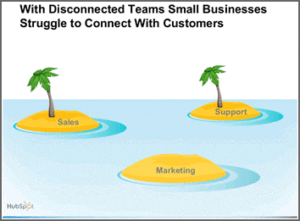 In a recent webinar, Brian Halligan, co-founder of HubSpot, identified 3 tectonic shifts in today’s business that affect all marketers and sales people of any size business, in any industry.The core issue underlying these changes is that we have a disconnect between marketing, sales & support teams in our companies. These departments struggle to connect with customers, while each prospect and customer wants to be treated differently, uniquely, to be treated as an individual with specific needs, challenges, goals, etc. Customer and prospects expect this — and businesses need to adapt.
In a recent webinar, Brian Halligan, co-founder of HubSpot, identified 3 tectonic shifts in today’s business that affect all marketers and sales people of any size business, in any industry.The core issue underlying these changes is that we have a disconnect between marketing, sales & support teams in our companies. These departments struggle to connect with customers, while each prospect and customer wants to be treated differently, uniquely, to be treated as an individual with specific needs, challenges, goals, etc. Customer and prospects expect this — and businesses need to adapt.
Here are the three shifts you need to come to grips with to accelerate your busisness growth this year.
- Marketing is changing. Stop advertising and emailing and cold calling; “it’s irritating to people,” said Brian Halligan, co-founder of HubSpot. Start creating remarkable content to educate people. The way to market is with great, “remarkable” content. Content pulls people into your business and pushes them down the funnel. Content creates a personalized website experience for people; amazon.com is a great example of a website that gives each user a very personal experience.
- Sales is changing. Sales people are now get involved much later in the sales cycle than ever. Customers are now empowered with information and most often they know more than the sales rep. On the other side of the coin, lead intelligence allow sales reps to know more about a prospect than ever before and to use this information to have better interactions with the prospects.
- Customer support is changing. “Put systems in place to track your support,” said Brian. Customers don’t just call your help line. They go online to social networks to ask their questions. By listening to your customers online, not only you’re engaging them but you have the chance to re-sell them on your products. “Companies are ignoring the interactions online,” Brian said. “…Delight your way to success [by interacting with people online].”
How can companies adapt to changing customer demands? Unifying marketing, sales, and support teams, as difficult as it sounds, will provide a huge edge over your competition and better serve your prospects and customers.
Marketing: educating prospects and building engagement
Marketing has changed dramatically in the past few years. It’s no longer about traditional advertising and trying to capture people’s attention — marketing is about educating people and attracting them into your business. It’s about personalized communication. Instead of broadcasting, it’s about “narrow-casting all the way down to 1:1.
Marketing is about using your brain and creativity, rather than your dollars. It’s not how much you can spend, it’s about how you can create remarkable and engaging content. It’s about being personal, valuable, meaningful, engaging, respectful,thoughtful and informative.
Marketing is about using your brain and creativity, rather than your dollars.
The way people consume such engaging content is changing fast, too! Digital consumers are viewing vast quantities of information on the the web, on mobile platforms, and in their email, and through social media. And they expect the companies they deal with to understand this and provide suitable content across all these platforms and devices.
We find that we’re spending more and more time educating clients’ sales and support staffs and working to align marketing, sales and support in ways we never did before.
Marketers need to spend more time engaging with sales and support staff to educate them about how your company is responding to these changes. Does you sales staff know that you blog every day? Are they listening on Twitter or Facebook like you are? Are they able to get a dynamic and complete picture of each prospect, not only with demographics information, but social media streams and website activity, too? Are they able to track the people they’re talking to through the entire buying process?
Sales: improving effectiveness with technology
One of the keys to providing current and complete information to Sales, is the selection of proper tools that marketing, sales and support can use, and the appropriate integration of these tools for each department. We want to empower our sales teams to sell more effectively with shared customer insights and information. We can help them do this by:
- getting real-time customer updates in one place
- gaining insights from every point-of-contact
- integrating social and traditional activity into one location
- expanding their knowledge with instant connection to experts
- streamlining collaboration on proposals and dashboards
- sharing private information directly with partners and customers
There are a variety of new tools that easily let us connect multiple software platforms, letting us synch and backup data among a wide variety of platforms. We recently used CloudHQ.net to connect two different Google Drive accounts to Basecamp, and created a seamless real-time integration between HubSpot and InsideSales. This past week we also worked with Nimble CRM to provide a more sales-ready integration between their software and HubSpot.
In addition to providing appropriate software tools, it makes sense to train your sales staff to use social media to support the company’s marketing efforts. Your salespeople are experts on talking with people, so give them access and education to help them “talk” with people on social media. Your training should include at least Twitter, LinkedIn, and Facebook. Add other social media that fits for your company.
Sales Takeaway: Be relevant, with a complete view of the prospect, and gain visibility to take action.
Support: knowledge is power!
People today are discussing your brands in every imaginable venue: blog comments, social media, email, chat rooms, forums and hangouts.
88% of people are unlikely to buy from companies that ignore their online complaints.*
Most businesses are not listening on social media.
- 95% of Facebook brand posts are not answered.*
- 71% of Twitter complaints are not answered.*
This provides your company with a huge opportunity. But how does a small business keep up with this exploding demand from customers and prospects?
Today’s support team needs to be connected to both the marketing process and the sales process, and need the same training that salespeople get regarding what’s happening in marketing. In addition, your support teams can provide a feedback loop to marketing about what they’re seeing in support.
Your support team needs to listen everywhere! They need to be connected to all channels: both tradional and social. Social is the new 800 number: you’ll often hear about things first on social, IF you’re listening.
Put a software system in place to track and manage issues. This will help provide consistency of response within the company’s time frame. Be sure to give every customer inquiry a status and an owner. Move your cases from open to resolved so no customer falls through the cracks.
 After your customer support team has been up and running awhile, build out a knowledge base so that every staff member is a smart as the best. Publish your FAQs to the website so that your customers (and prospects) can help themselves. The mantra in customer support should be “Continuous improvement”. . . not delayed perfection.
After your customer support team has been up and running awhile, build out a knowledge base so that every staff member is a smart as the best. Publish your FAQs to the website so that your customers (and prospects) can help themselves. The mantra in customer support should be “Continuous improvement”. . . not delayed perfection.
Finally, be sure you measure what gets done and how long it takes to do it. You’ll probably want to track number of new cases, case categorization, average time to first response, average interactions to resolution, and customer satisfaction.
Support Takeaways: Take charge of your customer support and engage with you customers where they are.
Final notes
Aligning your marketing, sales and support teams will help you grow in 2013. Use appropriate software to power interaction among teams, within teams, and with customer and prospects. Make sure you setup integrations between these various software platforms so you don’t end up with “silos of data.” And don’t worry. . . you’ll never get it “right.” Continuous improvement is the order of the day.
If you have questions about aligning your sales, marketing and support teams, you can ask them in the comment below, or contact us. We’d be happy to share some ideas!





